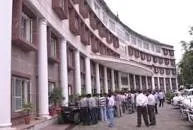‘New Parliament building a Atmanirbhar Bharat sign’

Prime Minister Narendra Modi on Thursday laid the foundation stone of the new Parliament complex, saying the new building will be the witness of Atmanirbhar Bharat.
Pujaris from Sringeri Math performed the rituals for the “Bhoomi Pujan” conducted by the Prime Minister, followed by prayers by all religious groups. Later the PM laid the foundation stone of the new building in the presence of Lok Sabha Speaker Om Birla and Rajya Sabha Deputy Chairperson Harivansh. The messages of President Ram Nath Kovind and Vice President Venkaiah Naidu were read out in the function.
The new Parliament building in 64,500 square metre will cost `971 crore and is estimated to be completed by 2022 and expected to conduct the session on 75th anniversary of Independence.
Union Ministers Rajnath Singh, Amit Shah, Ravi Shankar Prasad, Hardeep Singh Puri, Dharmendra Pradhan and many foreign envoys attended the function.
“This is a day of pride for over 130 crore Indians when we are witnessing this historic moment. The new Parliament building is an example of the co-existence of the new and the old. This is an effort to make changes within oneself in accordance with time and needs. The old building fulfilled the needs of the country, the new Parliament building will fulfill the country’s aspirations. If the old Parliament House gave direction to post-Independence India, the new building would become a witness to the creation of ‘Aatmanirbhar Bharat’,” said Modi.
Terming the current Parliament building constructed 100 years ago as the beacon of democracy, the PM said it had fulfilled the needs of the country, and the new building will fulfill the country’s aspirations and ambitions. Modi said the new Parliament complex will help the legislators as well as those who come to meet them. He said there were space constraints in the old building that has been taken care of in the new complex.
“The current Parliament building is nearly 100 years old. It was upgraded many times, but now it needs rest,” said PM.
Speaking on the history of democracy in India, the PM said many texts available here are older than the Magna Carta, which is considered the foundation of democracy. “Magna Carta was written in 13th century, but philosopher Basavanna envisioned a public Parliament in 12th century in the form of Anubhav Mantapa,” said Modi.
“If we go back further, some ancient inscriptions in Tamil Nadu from 10th century talk about categorising villages into groups – like modern day wards. They also talked about disqualifying public representatives from contesting elections. The criteria was to declare the contestants and their relatives’ assets,” he added.
The PM said it is ironic that other countries teach India about democracy. “When other countries talk about democracy, they only discuss elections and other administrative issues. But in India, democracy is a sacred, a way of life. The democratic system has been developed based on centuries long experiences. There were several changes, but the spirit remained as it is. Ironically, other countries teach is about democracy. I think that day will soon come when our countries will say ‘India is the mother of democracy’,” he said.
The PM said there can be differences of opinions in a democracy, but the ultimate goal should be to serve people. “We’ll have to take the pledge of ‘India First’. Our decisions should make the nation stronger and be measured on the same scale – that nation’s welfare comes first. Our efforts in the next 25-26 years should be towards how we want to see India in 2047, in our 100 years of Independence,” said Modi.
Tata Projects is the constructor of the building and Ratan Tata also attended the function. However, no construction can immediately begin as various pleas against the project are pending before the Supreme Court. The current Parliament building was constructed by the British and its foundation stone was laid on February 12, 1921.
The new building will also have a grand Constitution Hall to showcase India’s democratic heritage, a lounge for members of Parliament, a library, multiple committee rooms, dining areas, and ample parking space.
The Lok Sabha chamber will have a seating capacity for 888 members, while Rajya Sabha will have 384 seats, keeping in mind the future increase in the number of members for the two Houses. There will be no Central Hall in the new building and a joint Session will be convened at Lok Sabha. The new Lok Sabha chamber will be able to accommodate 1,224 members. The existing Parliament building will be conserved as it is an archaeological asset of the country, Speaker Om Birla said earlier.
Friday, 11 December 2020 | PNS | New Delhi





